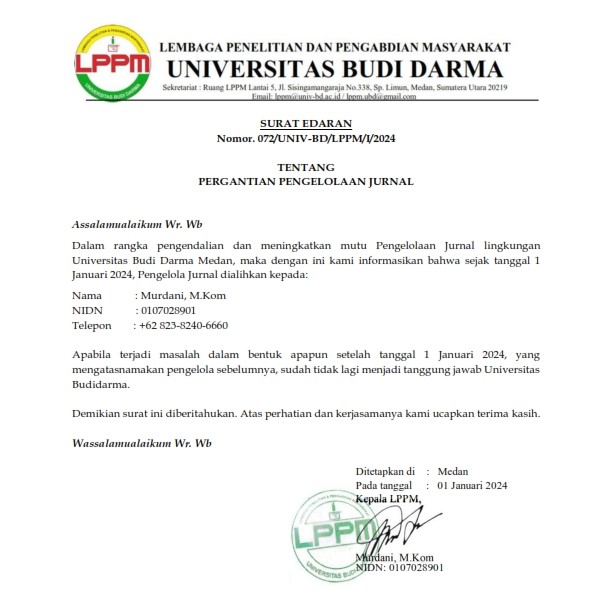Implementasi K-Means Clustering Ujian Nasional Sekolah Menengah Pertama di Indonesia Tahun 2018/2019
DOI:
https://doi.org/10.30865/mib.v4i1.1784Keywords:
Clustering, Data Mining, K-Means, Euclidean Distance, National ExamAbstract
Clustering is an activity that aims to group a data that has a similarity between one data with another data. K-Means clustering is a non-hierarchical data clustering method that attempts to partition existing data into one or more clusters / groups. In this study clustering was conducted using the K-Means algorithm using data on the achievements of the National Middle School National Examination in 2018 obtained from the official website of the Center for Education and Culture Assessment of the Ministry of Education and Culture of the Republic of Indonesia. The results of the cluster with the K-Means algorithm are obtained for cluster 1 there are 14 provinces, cluster 2 there are 5 provinces, and cluster 3 there are 15 provinces with cluster 1 level is a cluster with a high national test score, cluster 2 is a cluster with a low national test score and a cluster 3 is a cluster with moderate national examination scores. While the results of the evaluation of the K-Means algorithm with the number of clusters 3 produce an evaluation value of Connectivity 11,916, Dunn 0.246 and Silhouette 0.464.
References
M. Nishom, “Perbandingan Akurasi Euclidean Distance , Minkowski Distance , dan Manhattan Distance pada Algoritma K- Means Clustering berbasis Chi-Square,†J. Inform. J. Pengemb. IT, vol. 04, no. 01, pp. 20–24, 2019.
M. Anggara, H. Sujiani, and H. Nasution, “Pemilihan Distance Measure Pada K-Means Clustering Untuk Pengelompokkan Member Di Alvaro Fitness,†J. Sist. dan Teknol. Inf., vol. 1, no. 1, pp. 1–6, 2016.
M. H. Adiya and Y. Desnelita, “Jurnal Nasional Teknologi dan Sistem Informasi Penerapan Algoritma K-Means Untuk Clustering Data Obat-Obatan Pada RSUD Pekanbaru,†J. Nas. Teknol. DAN Sist. INFORMAS, vol. 05, no. 1, pp. 17–24, 2019.
F. L. Sibuea and A. Sapta, “PEMETAAN SISWA BERPRESTASI MENGGUNAKAN METODE K-MEANS CLUSTERING,†JURTEKSI (Jurnal Teknol. dan Sist. Informasi), vol. IV, no. 1, 2017.
T. W. P. A.A.Ngr Wisnu Gautama, Yudha Purwanto, “Analisis Pengaruh Penggunaan Manhattan Distance Pada Algoritma Clustering Isodata ( Self- Organizing Data Analysis Technique) Untuk Sistem Deteksi Anomali Trafik,†e-Proceeding Eng., vol. 2, no. 3, pp. 7404–7411, 2015.
R. Andrea, S. Palupi, and S. Qomariah, “CLUSTERING TIPE BELAJAR SISWA SMKN 2 PENAJAM PASER UTARA DENGAN PENERAPAN METODE DATA MINING K-MEANS DAN FUZZY C-MEANS ( FCM ) CLUSTER ANALYSIS FOR LEARNING STYLE OF VOCATIONAL HIGH SCHOOL STUDENT USING K-MEANS AND FUZZY C-MEANS ( FCM ),†J. Penelit. Pos dan Inform., vol. 7, no. 2, pp. 121–128, 2017.
C. D. Rumiarti and I. Budi, “SEGMENTASI PELANGGAN PADA CUSTOMER RELATIONSHIP MANAGEMENT DI PERUSAHAAN RITEL: STUDI KASUS PT GRAMEDIA ASRI MEDIA,†J. Sist. Inf. ( J. Inf. Syst. ), vol. 13, pp. 1–10, 2017.
R. Rizaldi, A. Kurniawati, and C. V. Angkoso, “Implementasi Metode Euclidean Distance untuk Rekomendasi Ukuran Pakaian pada Aplikasi Ruang Ganti Virtual,†J. Teknol. Inf. dan Ilmu Komput., vol. 5, no. 2, p. 129, 2018.
A. D. Savitri, F. A. Bachtiar, and N. Y. Setiawan, “Segmentasi Pelanggan Menggunakan Metode K-Means Clustering Berdasarkan Model RFM Pada Klinik Kecantikan (Studi Kasus : Belle Crown Malang),†J. Pengemb. Teknol. Inf. dan Ilmu Komput. Univ. Brawijaya, vol. 2, no. 9, pp. 2957–2966, 2018.
A. F. Khairati, A. A. Adlina, G. F. Hertono, and B. D. Handari, “Kajian Indeks Validitas pada Algoritma K-Means Enhanced dan K-Means MMCA,†Pros. Semin. Nas. Mat., vol. 2, pp. 161–170, 2019.
B. N. Sari and A. Primajaya, “Penerapan Clustering Dbscan untuk Pertanian Padi di Kabupaten Karawang,†JIKO (Jurnal Inform. dan Komputer) STMIK AKAKOM, vol. 4, no. 1, pp. 28–34, 2019.
S. M. Kim, M. I. Peña, M. Moll, G. Giannakopoulos, G. N. Bennett, and L. E. Kavraki, “An evaluation of different clustering methods and distance measures used for grouping metabolic pathways,†Proc. 8th Int. Conf. Bioinforma. Comput. Biol. BICOB 2016, no. BICoB, pp. 115–122, 2016.
“Laporan Hasil Ujian Nasional,†2018. [Online]. Available: https://hasilun.puspendik.kemdikbud.go.id/.
A. E. Wicaksono, “Implementasi Data Mining Dalam Pengelompokan Peserta Didik di Sekolah untuk Memprediksi Calon Penerima Beasiswa Dengan Menggunakan Algoritma K-Means (Studi Kasus SMA N 6 Bekasi),†Jur. Tek. Inform. Univ. Gunadarma, vol. 21, no. 3, pp. 206–216, 2016.
N. Puspitasari, U. Mulawarman, H. Haviluddin, and U. Mulawarman, “PENERAPAN METODE K-MEANS DALAM PENGELOMPOKKAN CURAH HUJAN,†Proc. Semin. Nas. Ris. Ilmu Komput. (SNRIK 2016), vol. I, no. December, 2016.
S. F. Putra, R. Pradina, and I. Hafidz, “Feature Selection pada Dataset Faktor Kesiapan Bencana pada Provinsi di Indonesia Menggunakan Metode PCA (Principal Component Analysis),†J. Tek. ITS, vol. 5, no. 2, pp. 5–9, 2016.
Downloads
Published
Issue
Section
License

This work is licensed under a Creative Commons Attribution 4.0 International License
Authors who publish with this journal agree to the following terms:
- Authors retain copyright and grant the journal right of first publication with the work simultaneously licensed under Creative Commons Attribution 4.0 International License that allows others to share the work with an acknowledgment of the work's authorship and initial publication in this journal.
- Authors are able to enter into separate, additional contractual arrangements for the non-exclusive distribution of the journal's published version of the work (e.g., post it to an institutional repository or publish it in a book), with an acknowledgment of its initial publication in this journal.
- Authors are permitted and encouraged to post their work online (e.g., in institutional repositories or on their website) prior to and during the submission process, as it can lead to productive exchanges, as well as earlier and greater citation of published work (Refer to The Effect of Open Access).



